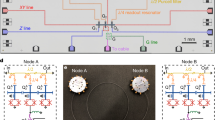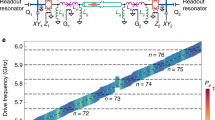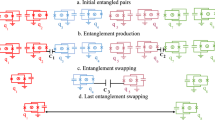Abstract
Sharing information coherently between nodes of a quantum network is fundamental to distributed quantum information processing. In this scheme, the computation is divided into subroutines and performed on several smaller quantum registers that are connected by classical and quantum channels1. A direct quantum channel, which connects nodes deterministically rather than probabilistically, achieves larger entanglement rates between nodes and is advantageous for distributed fault-tolerant quantum computation2. Here we implement deterministic state-transfer and entanglement protocols between two superconducting qubits fabricated on separate chips. Superconducting circuits3 constitute a universal quantum node4 that is capable of sending, receiving, storing and processing quantum information5,6,7,8. Our implementation is based on an all-microwave cavity-assisted Raman process9, which entangles or transfers the qubit state of a transmon-type artificial atom10 with a time-symmetric itinerant single photon. We transfer qubit states by absorbing these itinerant photons at the receiving node, with a probability of 98.1 ± 0.1 per cent, achieving a transfer-process fidelity of 80.02 ± 0.07 per cent for a protocol duration of only 180 nanoseconds. We also prepare remote entanglement on demand with a fidelity as high as 78.9 ± 0.1 per cent at a rate of 50 kilohertz. Our results are in excellent agreement with numerical simulations based on a master-equation description of the system. This deterministic protocol has the potential to be used for quantum computing distributed across different nodes of a cryogenic network.
This is a preview of subscription content, access via your institution
Access options
Access Nature and 54 other Nature Portfolio journals
Get Nature+, our best-value online-access subscription
$29.99 / 30 days
cancel any time
Subscribe to this journal
Receive 51 print issues and online access
$199.00 per year
only $3.90 per issue
Buy this article
- Purchase on Springer Link
- Instant access to full article PDF
Prices may be subject to local taxes which are calculated during checkout




Similar content being viewed by others
References
Cirac, J. I., Ekert, A. K., Huelga, S. F. & Macchiavello, C. Distributed quantum computation over noisy channels. Phys. Rev. A 59, 4249–4254 (1999).
Jiang, L., Taylor, J. M., Sørensen, A. S. & Lukin, M. D. Distributed quantum computation based on small quantum registers. Phys. Rev. A 76, 062323 (2007).
Wallraff, A. et al. Strong coupling of a single photon to a superconducting qubit using circuit quantum electrodynamics. Nature 431, 162–167 (2004).
Reiserer, A. & Rempe, G. Cavity-based quantum networks with single atoms and optical photons. Rev. Mod. Phys. 87, 1379–1418 (2015).
Eichler, C. et al. Observation of entanglement between itinerant microwave photons and a superconducting qubit. Phys. Rev. Lett. 109, 240501–240505 (2012).
Wenner, J. et al. Catching time-reversed microwave coherent state photons with 99.4% absorption efficiency. Phys. Rev. Lett. 112, 210501 (2014).
Johnson, B. R et al. Quantum non-demolition detection of single microwave photons in a circuit. Nat. Phys. 6, 663–667 (2010).
DiCarlo, L. et al. Demonstration of two-qubit algorithms with a superconducting quantum processor. Nature 460, 240–244 (2009).
Pechal, M. et al. Microwave-controlled generation of shaped single photons in circuit quantum electrodynamics. Phys. Rev. X 4, 041010 (2014).
Koch, J. et al. Charge-insensitive qubit design derived from the Cooper pair box. Phys. Rev. A 76, 042319 (2007).
Julsgaard, B., Kozhekin, A. & Polzik, E. S. Experimental long-lived entanglement of two macroscopic objects. Nature 413, 400–403 (2001).
Chou, C. W. et al. Measurement-induced entanglement for excitation stored in remote atomic ensembles. Nature 438, 828–832 (2005).
Choi, K. S., Goban, A., Papp, S. B., van Enk, S. J. & Kimble, H. J. Entanglement of spin waves among four quantum memories. Nature 468, 412–416 (2010).
Roch, N. et al. Observation of measurement-induced entanglement and quantum trajectories of remote superconducting qubits. Phys. Rev. Lett. 112, 170501 (2014).
Slodička, L. et al. Atom-atom entanglement by single-photon detection. Phys. Rev. Lett. 110, 083603 (2013).
Delteil, A. et al. Generation of heralded entanglement between distant hole spins. Nat. Phys. 12, 218–223 (2016).
Moehring, D. L. et al. Entanglement of single-atom quantum bits at a distance. Nature 449, 68–71 (2007).
Lee, K. C. et al. Entangling macroscopic diamonds at room temperature. Science 334, 1253–1256 (2011).
Hofmann, J. et al. Heralded entanglement between widely separated atoms. Science 337, 72–75 (2012).
Bernien, H. et al. Heralded entanglement between solid-state qubits separated by three metres. Nature 497, 86–90 (2013).
Matsukevich, D. N. et al. Entanglement of remote atomic qubits. Phys. Rev. Lett. 96, 030405 (2006).
Ritter, S. et al. An elementary quantum network of single atoms in optical cavities. Nature 484, 195–200 (2012).
Axline, C. et al. On-demand quantum state transfer and entanglement between remote microwave cavity memories. Nat. Phys. https://doi.org/10.1038/s41567-018-0115-y (2018).
Campagne-Ibarcq, P. et al. Deterministic Remote Entanglement of Superconducting Circuits through Microwave Two-Photon Transitions. Phys. Rev. Lett. 120, 200501 (2018).
Cirac, J. I., Zoller, P., Kimble, H. J. & Mabuchi, H. Quantum state transfer and entanglement distribution among distant nodes in a quantum network. Phys. Rev. Lett. 78, 3221–3224 (1997).
Reed, M. D. et al. Fast reset and suppressing spontaneous emission of a superconducting qubit. Appl. Phys. Lett. 96, 203110 (2010).
Walter, T. et al. Rapid, high-fidelity, single-shot dispersive readout of superconducting qubits. Phys. Rev. Appl. 7, 054020 (2017).
Zeytinoğlu, S. et al. Microwave-induced amplitude- and phase-tunable qubit-resonator coupling in circuit quantum electrodynamics. Phys. Rev. A 91, 043846 (2015).
Kuhn, A., Hennrich, M. & Rempe, G. Deterministic single-photon source for distributed quantum networking. Phys. Rev. Lett. 89, 067901 (2002).
Magnard, P. et al. Fast and unconditional all-microwave reset of a superconducting qubit. Preprint at https://arxiv.org/abs/1801.07689 (2018).
Bozyigit, D. et al. Antibunching of microwave-frequency photons observed in correlation measurements using linear detectors. Nat. Phys. 7, 154–158 (2011).
van Enk, S. J., Lütkenhaus, N. & Kimble, H. J. Experimental procedures for entanglement verification. Phys. Rev. A 75, 052318 (2007).
Nielsen, M. A. & Chuang, I. L. Quantum Computation and Quantum Information 10th edn, Ch. 9 (Cambridge Univ. Press, New York, 2011).
Verstraete, F. & Wolf, M. M. Entanglement versus bell violations and their behavior under local filtering operations. Phys. Rev. Lett. 89, 170401 (2002).
Dickel, C. et al. Chip-to-chip entanglement of transmon qubits using engineered measurement fields. Phys. Rev. B 97, 064508 (2018).
Humphreys, P. C. et al. Deterministic delivery of remote entanglement on a quantum network. Preprint at https://arxiv.org/abs/1712.07567 (2017).
Jeffrey, E. et al. Fast accurate state measurement with superconducting qubits. Phys. Rev. Lett. 112, 190504 (2014).
Sete, E. A., Martinis, J. M. & Korotkov, A. N. Quantum theory of a bandpass Purcell filter for qubit readout. Phys. Rev. A 92, 012325 (2015).
Wallraff, A. et al. Approaching unit visibility for control of a superconducting qubit with dispersive readout. Phys. Rev. Lett. 95, 060501–060504 (2005).
Peterer, M. J. et al. Coherence and decay of higher energy levels of a superconducting transmon qubit. Phys. Rev. Lett. 114, 010501 (2015).
Motzoi, F., Gambetta, J. M., Rebentrost, P. & Wilhelm, F. K. Simple pulses for elimination of leakage in weakly nonlinear qubits. Phys. Rev. Lett. 103, 110501 (2009).
Gambetta, J. M., Motzoi, F., Merkel, S. T. & Wilhelm, F. K. Analytic control methods for high-fidelity unitary operations in a weakly nonlinear oscillator. Phys. Rev. A 83, 012308–012313 (2011).
Chow, J. M. et al. Randomized benchmarking and process tomography for gate errors in a solid-state qubit. Phys. Rev. Lett. 102, 090502 (2009).
Kurpiers, P., Walter, T., Magnard, P., Salathe, Y. & Wallraff, A. Characterizing the attenuation of coaxial and rectangular microwave-frequency waveguides at cryogenic temperatures. EPJ Quant. Technol. 4, 8 (2017).
Gardiner, C. W. Driving a quantum system with the output field from another driven quantum system. Phys. Rev. Lett. 70, 2269–2272 (1993).
Carmichael, H. J. Quantum trajectory theory for cascaded open systems. Phys. Rev. Lett. 70, 2273–2276 (1993).
Chuang, I. L. & Nielsen, M. A. Prescription for experimental determination of the dynamics of a quantum black box. J. Mod. Opt. 44, 2455–2467 (1997).
Gühne, O. & Tóth, G. Entanglement detection. Phys. Rep. 474, 1–75 (2009).
Bell, J. S. On the Einstein Podolsky Rosen paradox. Phys. Phys. Fiz. 1, 195–200 (1964).
Clauser, J. F., Horne, M. A., Shimony, A. & Holt, R. A. Proposed experiment to test local hidden-variable theories. Phys. Rev. Lett. 23, 880–884 (1969).
Chou, C.-W. et al. Functional quantum nodes for entanglement distribution over scalable quantum networks. Science 316, 1316–1320 (2007).
Laurat, J., Choi, K. S., Deng, H., Chou, C. W. & Kimble, H. J. Heralded entanglement between atomic ensembles: preparation, decoherence, and scaling. Phys. Rev. Lett. 99, 180504 (2007).
Yuan, Z.-S. et al. Experimental demonstration of a BDCZ quantum repeater node. Nature 454, 1098–1101 (2008).
Matsukevich, D. N., Maunz, P., Moehring, D. L., Olmschenk, S. & Monroe, C. Bell inequality violation with two remote atomic qubits. Phys. Rev. Lett. 100, 150404 (2008).
Maunz, P. et al. Heralded quantum gate between remote quantum memories. Phys. Rev. Lett. 102, 250502 (2009).
Hucul, D. et al. Modular entanglement of atomic qubits using photons and phonons. Nat. Phys. 11, 37–42 (2015).
Lettner, M. et al. Remote entanglement between a single atom and a Bose-Einstein condensate. Phys. Rev. Lett. 106, 210503 (2011).
Usmani, I. et al. Heralded quantum entanglement between two crystals. Nat. Photon. 6, 234–237 (2012).
Pfaff, W. et al. Unconditional quantum teleportation between distant solid-state quantum bits. Science 345, 532–535 (2014).
Hensen, B. et al. Loophole-free bell inequality violation using electron spins separated by 1.3 kilometres. Nature 526, 682–686 (2015).
Narla, A. et al. Robust concurrent remote entanglement between two superconducting qubits. Phys. Rev. X 6, 031036 (2016).
Stockill, R. et al. Phase-tuned entangled state generation between distant spin qubits. Phys. Rev. Lett. 119, 010503 (2017).
Acknowledgements
This work was supported by the European Research Council (ERC) through the ‘Superconducting Quantum Networks’ (SuperQuNet) project, by the National Centre of Competence in Research ‘Quantum Science and Technology’ (NCCR QSIT), a research instrument of the Swiss National Science Foundation (SNSF), by ETH Zurich and NSERC, the Canada First Research Excellence Fund and the Vanier Canada Graduate Scholarships.
Author information
Authors and Affiliations
Contributions
The experiment was designed and developed by P.K., T.W., P.M. and M.P. The samples were fabricated by J.-C.B., T.W. and S.G. The experiments were performed by P.K., P.M. and T.W. The data were analysed and interpreted by P.K., P.M., B.R., A.B. and A.W. The FPGA firmware and experiment automation was implemented by J.H., Y.S., A.A., S.S., P.M. and P.K. The master-equation simulations were performed by B.R., M.P., P.M. and P.K. The manuscript was written by P.K., P.M., T.W., B.R. and A.W. All authors commented on the manuscript. The project was led by A.W.
Corresponding authors
Ethics declarations
Competing interests
The authors declare no competing interests.
Additional information
Publisher’s note: Springer Nature remains neutral with regard to jurisdictional claims in published maps and institutional affiliations.
Extended data figures and tables
Extended Data Fig. 1 Overview of remote-entanglement experiments.
a, Entanglement generation rate Γent. b, CHSH–Bell inequality49,50 correlation S. c, Concurrence \({\mathscr{C}}\). d, Entangled state fidelity \({{\mathscr{F}}}^{{\rm{s}}}\). The experiments are grouped by physical system: atomic ensembles (‘ae’)12,21,51,52,53, trapped ions (‘ion’)15,17,54,55,56, single-atom Bose–Einstein condensate (‘sab’)57, vibrational state of diamonds (‘vs’)18, rare-Earth-doped crystals (‘rec’)58, single atoms (‘sa’)19,22, nitrogen–vacancy centres (‘nv’)20,36,59,60, superconducting circuits (‘sc’)14,23,24,35,61 or quantum dots (‘qd’)16,62. The colours indicate different implementations: probabilistic unheralded (red), probabilistic heralded (blue), guaranteeing a deterministic delivery of an entangled state at a pre-specified time (yellow) or fully deterministic (green). The plot markers indicate different schemes for realizing the remote interaction: measurement-induced (triangles), single-photon (crosses) or two-photon (squares) interference and detection, direct transfer (diamond) or direct transfer with shaped photons (circles). The lines in c are bounds34 on the concurrence \({\mathscr{C}}\) calculated from measured CHSH–Bell correlations S. The shaded column highlights this study.
Extended Data Fig. 2 Micrograph of sample and energy-level diagram.
a, False-colour micrograph of a sample of the same design co-fabricated with the one used for node A. The circuit elements are colour coded as in Fig. 1: transfer circuit (yellow), readout circuit (grey), transmon (orange) and input lines of the transmon and readout circuit (blue). The input to the transfer circuit is used as an auxiliary port to perform resonator spectroscopy in transmission. The inset shows a scanning electron microscopy (SEM) micrograph of the asymmetric SQUID with a ratio of 5:1 between the areas of the Josephson junctions used in the transmon. b, Schematic of the energy-level diagram of the coupled transmon-transfer resonator system. The numerical values of all parameters are listed in Extended Data Table 1.
Extended Data Fig. 3 a.c. Stark shift and Rabi rate of the \(\left|f,0\right\rangle \leftrightarrow \left|g,1\right\rangle \) transition.
a, b, Measurement (filled circles) of the a.c. Stark shift Δf0g1/(2π) (a) and the effective coupling \(\widetilde{g}/\left(2{\rm{\pi }}\right)\) of the \(\left|f,0\right\rangle \leftrightarrow \left|g,1\right\rangle \) transition (b) versus drive amplitude εf0g1 for sample A (blue) and B (red). The solid lines in a (b) are quadratic (linear) fits to the data30.
Extended Data Fig. 4 Qutrit single-shot readout characterization.
a–f, Scatter plot of the measured integrated quadrature values u and v for qutrit A (a–c) and B (d–f) when prepared in state \(\left|g\right\rangle \) (blue; a, d), \(\left|e\right\rangle \) (red; b, e) and \(\left|f\right\rangle \) (green; c, f). We plot only the first 1,000 of the 25,000 repetitions for each state-preparation experiment. The dashed lines are the qutrit-state discrimination thresholds used to obtain the assignment probabilities (numbers, which are also listed in Extended Data Table 2).
Extended Data Fig. 5 Characterization of entangled states in a two-qutrit basis.
a–c, Two-qutrit state tomography: real (a) and imaginary (b) part of the density matrix and expectation values of the Gell–Mann operators λ k (c). The ideal Bell state \(\left|{\psi }^{+}\right\rangle \) and numerical master-equation simulation are depicted as grey and red outlines, respectively. λ0 denotes the identity operation, λ1,2,3 denote the Pauli matrices \({\sigma }_{x,y,z}^{{\rm{ge}}}\) in the qubit subspace, λ4,5 correspond to \({\sigma }_{x,y}^{{\rm{gf}}}\), λ6,7 correspond to \({\sigma }_{x,y}^{{\rm{ef}}}\) and λ8 is the diagonal matrix \(\left({\sigma }_{z}^{{\rm{ge}}}+2{\sigma }_{z}^{{\rm{ef}}}\right){\rm{/}}\sqrt{3}\). The trace distance between the measurement and the simulation is 0.107.
Rights and permissions
About this article
Cite this article
Kurpiers, P., Magnard, P., Walter, T. et al. Deterministic quantum state transfer and remote entanglement using microwave photons. Nature 558, 264–267 (2018). https://doi.org/10.1038/s41586-018-0195-y
Received:
Accepted:
Published:
Issue Date:
DOI: https://doi.org/10.1038/s41586-018-0195-y
This article is cited by
-
Non-classical microwave–optical photon pair generation with a chip-scale transducer
Nature Physics (2024)
-
On-demand directional microwave photon emission using waveguide quantum electrodynamics
Nature Physics (2023)
-
Low-loss interconnects for modular superconducting quantum processors
Nature Electronics (2023)
-
Realizing all-to-all couplings among detachable quantum modules using a microwave quantum state router
npj Quantum Information (2023)
-
Photons go one way or another
Nature Physics (2023)
Comments
By submitting a comment you agree to abide by our Terms and Community Guidelines. If you find something abusive or that does not comply with our terms or guidelines please flag it as inappropriate.



